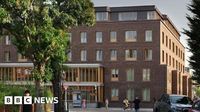In a year marked by fierce competition and architectural innovation, the Appleby Blue Almshouse in Bermondsey, Southwark, south London, has been awarded the Royal Institute of British Architects' (RIBA) Stirling Prize for 2025. The announcement, made on October 16, 2025, heralds a new chapter in British social housing, particularly for older residents seeking community, dignity, and comfort later in life.
The Appleby Blue Almshouse is no ordinary housing complex. Designed by the acclaimed architecture firm Witherford Watson Mann, the project offers 59 affordable flats for people over the age of 65. But it’s not just about providing a roof over one's head. The complex is packed with communal facilities—a roof garden, a courtyard, and a community kitchen—that foster connection and combat the all-too-common scourge of loneliness among older adults. According to the BBC, the Stirling Prize judges praised the development for setting "an ambitious standard for social housing among older people."
The vision behind Appleby Blue was clear: create a living environment that feels less like an institution and more like a home. Jury member Ingrid Schroder, director of the Architectural Association School of Architecture, highlighted the architects' success, stating they have crafted "high-quality and thoughtful spaces to create environments that truly care for their residents." These aren’t just buzzwords—every detail of the building, from the generous homes to the terracotta-paved hallways lined with benches and plants, is designed to encourage social interaction and a sense of belonging. Even the water feature, which evokes the feeling of a woodland oasis, contributes to what RIBA calls an "aspirational living environment."
The almshouse stands on the site of a former care home, breathing new life into a space that once served the community in a different way. Its construction was spearheaded by United St Saviour's Charity, a centuries-old organization with a mission to support Southwark’s most vulnerable residents. By subsidizing the flats, the charity ensures that people on low incomes can afford to live in this innovative development. This approach harks back to the original purpose of almshouses, which have existed in Britain since the Middle Ages to provide charitable accommodation for those in need.
But what sets Appleby Blue apart from traditional almshouses—or even many contemporary senior housing projects—is its focus on dignity and agency. The design avoids the institutional feel that can make older people feel isolated or marginalized. Instead, the spaces are open, filled with light, and connected to nature and community. As RIBA put it, Appleby Blue "stands in stark contrast to the institutional atmosphere often associated with older people's housing."
The Stirling Prize is no small accolade. Established in 1996, it is awarded annually to the building judged to be "the most significant of the year for the evolution of architecture and the built environment." The criteria are demanding: design vision, innovation, and originality are all taken into account. Witherford Watson Mann’s win this year marks the second time the firm has taken home the prize, following their groundbreaking holiday home inside the ancient Astley Castle in Warwickshire twelve years ago. Their repeated recognition is a testament to their commitment to redefining what architecture can do for people and communities.
The competition for this year's Stirling Prize was particularly stiff. Other nominees included the painstaking restoration of London’s iconic Big Ben tower, a cutting-edge fashion college campus, a state-of-the-art science laboratory, and an inventive home extension. Yet, it was Appleby Blue’s blend of tradition and modernity, its social mission, and its thoughtful design that ultimately swayed the judges. According to The Guardian, the building “beat a range of other nominated buildings and architecture projects to this year’s Stirling Prize.”
This victory places Appleby Blue in esteemed company. Previous winners of the Stirling Prize have included some of the UK’s most celebrated buildings, such as Liverpool’s Everyman Theatre, Hastings Pier, the Scottish Parliament building in Edinburgh, and last year’s winner, the Elizabeth Line—London’s ambitious east-west train line. Each of these projects, in its own way, has pushed the boundaries of what architecture can achieve, whether through civic engagement, engineering prowess, or cultural resonance.
Appleby Blue’s success also reflects broader trends in British architecture and social policy. As the UK’s population ages, there is increasing recognition of the need for housing that supports not just the physical health but also the emotional and social well-being of older adults. Projects like Appleby Blue show what’s possible when architects, charities, and local authorities work together to prioritize people over profit. The result is a living space that feels both modern and deeply rooted in the community’s history and values.
Of course, the journey to this point wasn’t without its challenges. Transforming the site of an old care home into a vibrant community hub required vision, tenacity, and a willingness to challenge conventional thinking about senior living. But the end result speaks for itself. Residents now enjoy homes that are not only affordable but also beautiful and welcoming—a rare combination in any city, let alone in the heart of London.
For Witherford Watson Mann, the Stirling Prize is both a recognition of past achievements and a call to action for the future. As cities around the world grapple with questions of aging, housing affordability, and social isolation, Appleby Blue stands as a beacon of what can be achieved when thoughtful design meets social purpose. As Ingrid Schroder aptly noted, these are “environments that truly care for their residents.”
In the end, the story of Appleby Blue Almshouse is about more than architecture. It’s about reimagining what it means to grow old in Britain—and doing so with dignity, community, and hope. As the doors of Appleby Blue open to its new residents, they also open to a future where buildings don’t just shelter people, but help them thrive.
